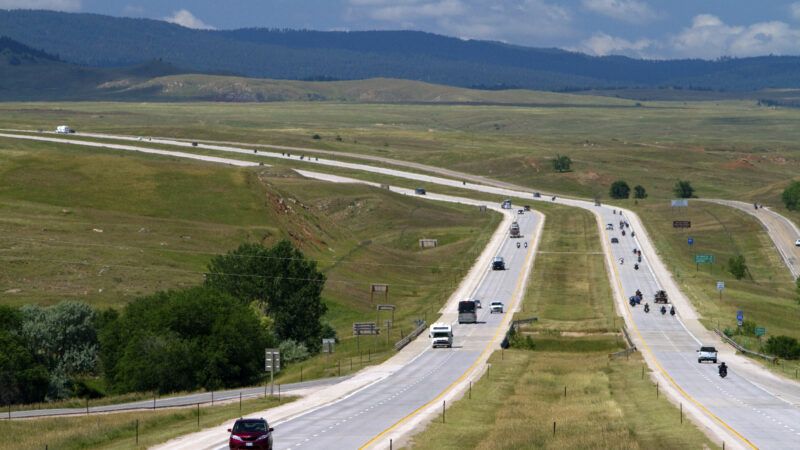Why Does American Infrastructure Cost More and Take Longer To Build Than It Used To?
A series of laws passed in the 1970s may have permanently hamstrung American infrastructure development.

In time-lapse videos from 2016 that are making the rounds again, Dutch crews can be seen building an entire highway overpass over a single weekend. That has stirred discussion of a longstanding question: Why is construction of public infrastructure slow and expensive in the United States compared with other advanced countries? New York City subways offer one famous example: The Second Avenue line now being partially constructed nearly 100 years after being proposed costs six times as much as a comparable project in Paris.
In a 2019 paper, Leah Brooks of George Washington University and Zachary D. Liscow of Yale University sought to explain a striking fact: "Real spending per mile on Interstate construction increased more than three-fold from the 1960s to the 1980s."
Two explanations frequently offered for this rise are plausible on the surface, but turn out to lack explanatory power. The first is that states built the easier sections of the interstate highway system first, and left for later the more difficult and expensive portions. It seems, however, the later-finished sections do not score worse on a scale of objective difficulty, such as population density, steepness, and the need to cross water barriers. There is also evidence that states' actual practice was in fact to build more difficult sections first because that is where the existing traffic bottlenecks were.
A second possible, but insufficient, explanation is that cost per mile began escalating steeply because of rises in the cost of major inputs, such as labor and materials. Again, this is plausible on its face, but Brooks and Liscow write that it is not supported by actual spending figures. The real, after-inflation cost of labor didn't change much during the period in which spending increased so dramatically. (While the Davis-Bacon Act, with its artificial wage floors, makes federal construction more expensive, that particular law dates back to 1931 and was in effect over the entire history of the interstate highway program.)
What forces, then, did drive the cost escalation? One key finding, the authors say, is that if a given community is wealthier, the state will wind up spending more to build a given mile of interstate. This effect increased over time.
To some extent, correlations of this sort might manifest themselves even if affluent neighborhoods do not exert any particular clout. Amenities that attract well-off residents, such as water views, may be the same ones highway builders take pains to avoid spoiling; municipalities may have reason to press for features such as noise barriers in places where property tax collections are high and officials have an incentive to keep property values from falling, and so forth.
Another possibility, however, is that wealthier persons are simply "more effective at voicing their interests in the political process." The highway route gets diverted in a way that protects their amenity, but spoils some equally valued amenity in a less affluent neighborhood. The unwelcome extension is completed far behind schedule, with concomitant expense, because opponents have been skillful at working the system by stretching out hearings and reviews and then suing.
And here is where the concept of "citizen voice" comes in. Brooks and Liscow pinpoint the early 1970s as the inflection point for increased spending on highway projects. What was happening around that time? The National Environmental Policy Act (NEPA), which requires environmental impact review for federally funded projects, was passed in 1970. California passed its considerably more stringent CEQA (California Environmental Quality Act) the same year, and it was signed by none other than Gov. Ronald Reagan. In 1972 and 1973, Congress added additional federal laws that provided key leverage in fighting construction projects on the basis of loss of species habitat and wetlands. The U.S. Supreme Court helped out with the 1971 case of Citizens To Preserve Overton Park v. Volpe, which multiplied the chances to go to court over development by curtailing judges' deference to agency decision making. All of these laws and decisions have made it much easier for citizens to contest infrastructure projects, driving up their cost and delaying their implementation and completion.
Among Brooks and Liscow's most interesting findings is this: The relationship between local resident income and project expense took off just as these changes in law were coming online. Before 1970, the two were related modestly enough that the correlation failed to score as statistically significant. It then proceeded to quintuple.
The story the authors tell is complicated, not simple. They do not dispute that the new "citizen voice" laws brought some authentic benefits; objectors could bring genuinely useful information to the highway planners about ways to avoid environmental harm. They write that they do not have the means to choose between the "benign" interpretation of the cost facts (citizen voice allowed government to spend money so as to avoid harms that would have been objectively costly) and the "malign" interpretation (the process improved the relative position of some favored parties without adding much social value overall).
Somewhere, though, the late William Tucker is smiling. In "Environmentalism and the Leisure Class," an influential 1977 Harper's Magazine essay later expanded into the 1982 book Progress and Privilege, Tucker argued that the environmentalist banner, when waved against local development, offers a conveniently genteel way to "favor the status quo" for those whose "material comfort under the present system has been more or less assured."


Show Comments (91)